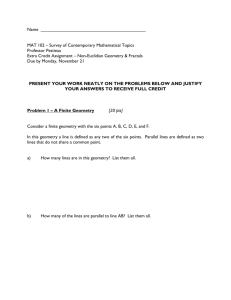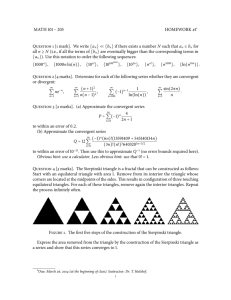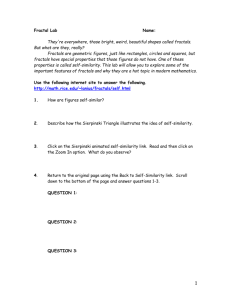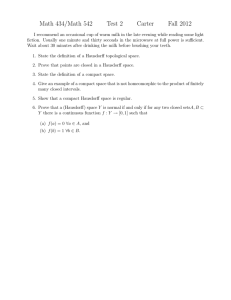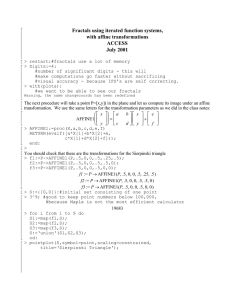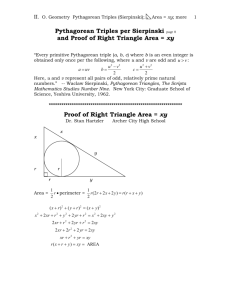Fractals in the Computer Age
advertisement
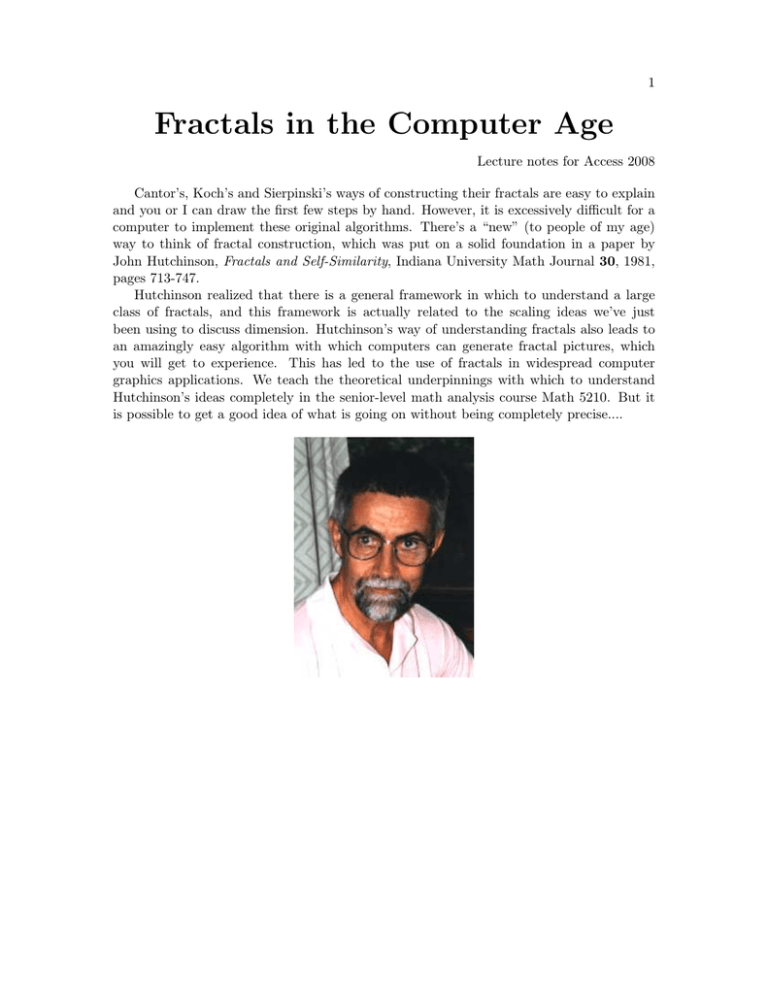
1
Fractals in the Computer Age
Lecture notes for Access 2008
Cantor’s, Koch’s and Sierpinski’s ways of constructing their fractals are easy to explain
and you or I can draw the first few steps by hand. However, it is excessively difficult for a
computer to implement these original algorithms. There’s a “new” (to people of my age)
way to think of fractal construction, which was put on a solid foundation in a paper by
John Hutchinson, Fractals and Self-Similarity, Indiana University Math Journal 30, 1981,
pages 713-747.
Hutchinson realized that there is a general framework in which to understand a large
class of fractals, and this framework is actually related to the scaling ideas we’ve just
been using to discuss dimension. Hutchinson’s way of understanding fractals also leads to
an amazingly easy algorithm with which computers can generate fractal pictures, which
you will get to experience. This has led to the use of fractals in widespread computer
graphics applications. We teach the theoretical underpinnings with which to understand
Hutchinson’s ideas completely in the senior-level math analysis course Math 5210. But it
is possible to get a good idea of what is going on without being completely precise....
2
We illustrate what Hutchinson realized with the Sierpinski Triangle example. Think
about how we rescaled this object in order to figure out its dimension, and now thing about
shrinking rather than expanding:
Let f1 , f2 , f3 be the three affine functions as shown below:
e.g. f1
x
y
=
1
2
0
0
1
2
x
y
+
1
4
1
2
3
Notice:
1. The Sierpinski triangle S is exactly the union of its three transformed copies, i.e.,
S = f1 (S) ∪ f2 (S) ∪ f3 (S).
Equivalently, consider the “cloning and shrinking” transformation applied to arbitrary
sets B (for Bob), given by
F (B) := f1 (B) ∪ f2 (B) ∪ f3 (B).
Then F (S) = S, i.e., Sierpinski’s triangle doesn’t get changed by the set transformation F .
2. Each of the transformations f1 , f2 , f3 shrinks Euclidean distances between pairs of
points by the scaling factor of 12 .
3. What happens if we successively apply the set transformation F to arbitrary subsets?
Can you explain the picture below, using (1) and (2)? It looks like if we clone and
shrink Bob enough times, he will turn into Sierpinski’s triangle too!
4
Explanation: First, we need a practical way to say that two sets, A and B in the
plane, are close to each other. One way that works is to see if every point in A is close
to some point in B, and vice-verse.
Precisely, we will say that the “distance” between A and B, dist(A, B), is either the
maximum distance points in A can be from (nearest points in) B; or, the maximum
distance points in B can be from A; dist(A, B) is the larger of these two numbers. In
fact, this distance is well known to advanced mathematics students, and is called the
“Hausdorff distance”, after Felix Hausdorff. Here are some sets to look at in order to
understand Hausdorff distance:
5
Using Hausdorff distance we can explain what happened in the Sierpinski Triangle
example:
Because each of the transformations f1 , f2 , f3 shrinks distances between points by a
factor of 21 , the set transformation F also shrinks Hausdorff distance between sets:
1
dist(F (A), F (B)) ≤ (dist(A, B))
2
always holds. Since the Sierpinski triangle S is left fixed by F , the Hausdorff distance
from Sierpinski to (the cloned and shrunken) F (Bob) is only half as large as the
original distance from Bob to S. If we compare F (F (Bob)) to S, they are only 14 the
distance apart as B and S were initially. After 10 steps, the iterated Bob will be only
1 10
as far from Sierpinski as he started. Certainly to our eyes, the two sets will be
2
indistinguishable.
That’s why we can begin with any initial set, the easiest of which would be a single
point, and simply iterate F a large number of times to create a set which is practically
indistinguishable form the real Sierpinski triangle.
The rest of Hutchinson’s brainstorm: You can begin with ANY finite collection of
transformations, f1 , f2 , f3 , . . . , fn , such that each transformation fi shrinks Euclidean
distances between pairs of points by at least a factor mi less than 1. (These transformations don’t have to be uniform scalings - for example they can be more general
affine transformations as long as they have the distance contracting property.) Then,
as with the Sierpinski example, define the cloning-shrinking transformation
F (S) := f1 (S) ∪ f2 (S) ∪ · · · ∪ fn (S).
This transformation will shrink the Hausdorff distance between pairs of transformed
sets, by a factor which is no larger than the largest shrinking factor for any of the
fi . Thus, as you successively iterate F on any two sets A and B, the corresponding
transformed sets get closer and closer, at a geometric rate.
In fact, we can start with any set A, and the iteration sequence {A, F (A), F (F (A)), . . .}
converges to a unique limit fractal determined by the choice of f1 , f2 , f3 , . . . fn . (The
Hausdorff distance between this fractal and the elements of the iteration sequence
converges to zero as the number of iterations approaches infinity.) SEE EXAMPLES.
